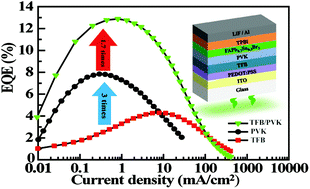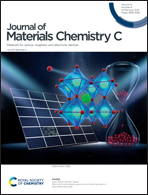High-performance perovskite light-emitting diodes based on double hole transport layers†
Abstract
Preparing perovskite light emitting diodes (PeLEDs) by a solution process leads to inevitable imbalanced carrier injection and solvent erosion, which prevent us from obtaining high-performance PeLEDs. Here, we report a facile method to fabricate green-emitting PeLEDs with double hole transport layers (HTLs) that significantly promote the hole injection and charge balance. To address the problem of solvent erosion, 1,4-dioxane was adopted as the solvent for poly(9-vinylcarbazole) (PVK) and it was cast onto the surface of poly[(9,9-dioctylfluorenyl-2,7-diyl)-co-(4,40-(N-(p-butylphenyl))-diphenylamine)] (TFB). At the same time, an orthogonal solvent 1,4-dioxane was employed to improve the surface smoothness of the perovskite film on the double HTLs. The PeLEDs with TFB/PVK double HTLs showed a maximum current efficiency (CE) and an EQE of 53.5 cd A−1 and 12.9%, respectively. The EQE of the device is about 1.7 and 3 times higher than that of the single HTL device with PVK and TFB, respectively. This remarkable improvement is mainly attributed to the cascade-like energy alignment of the double HTLs, which prevents charging in perovskite nanocrystals (NCs). This work offers a new insight into preparing high performance PeLEDs for displays and lighting devices.



 Please wait while we load your content...
Please wait while we load your content...